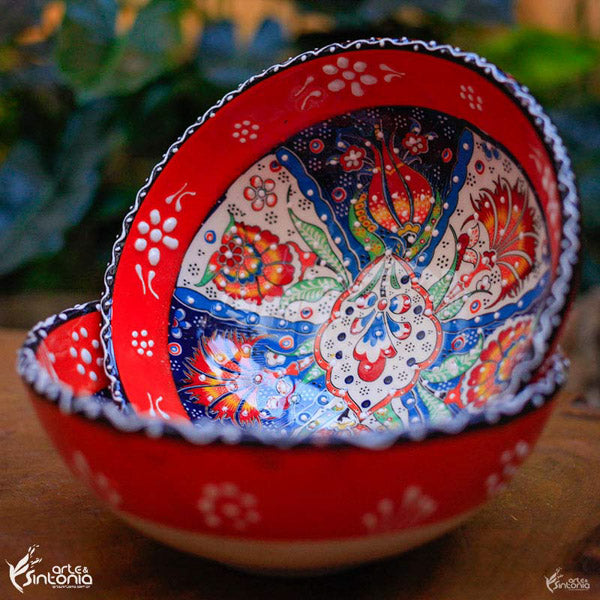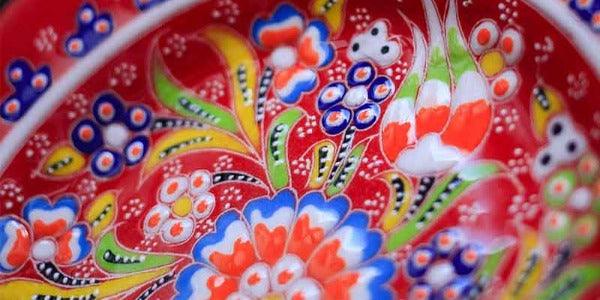From the skilled hands of traditional potters, Turkish ceramics take shape with decorative and/or utilitarian purposes, such as personalized plates and bowls with embossed designs and handcrafted paintings that radiate their colors in the environments. And how can you not be impressed by the beauty of unique floral patterns that support in every detail artistic influences and historical moments that form Turkey's cultural heritage ?
The origin of Turkish pottery art finds its roots in the history of Iranian Seljuk art and Islamic architecture with the production of tiles and " chini " tiles between the 8th and 9th centuries. After the conquest of the Seljuk Empire to the detriment of the Byzantine Empire in the c. In the 11th century, Anatolia became a major center of artistic production, mixing the cultural heritage of the peninsula with Iranian techniques of decorated ceramics from the Seljuks such as sgraffito , slip and dry cuerda .

Turkish pottery originates from the development of Islamic art in the Seljuk Empire.
The painting with floral motifs made on the surface of the dry ceramic (leather stitch) which is then carved, enameled and fired makes sgraffito particular ; while the slip is characterized by the technique of decorating wet ceramics with red and sliding paste that, after being glazed, is fired and takes on new shades.
Dry cuerda , a technique adopted from Central Asian artists, gave artisans in the Seljuk tradition the opportunity to develop ceramics with more complex and detailed surface designs using fine lines to separate the diversity of colored glazes such as cobalt blue and turquoise, pistachio green , yellow and black that printed geometric and floral patterns on the pieces.

Diverse floral motifs form the surface design of traditional Turkish ceramics.
The rise of the Ottoman Empire and the appreciation of the sultans for the traditional Chinese blue and white porcelain of the Yuan and Ming dynasties, in the transition from the 15th to the 16th century, impacted the development of Turkish ceramics in Iznik - ancient Nicaea, province of Anatolia - converting the ancestral style of Seljuk art in ceramics with peculiar compositions such as the Rumi-Hatayi that mixes Chinese florals ( hatayi ) represented by peonies or lotus flowers with Ottoman arabesque patterns ( rumi ).
The court's cultural stimulus with the creation of a guild of artisans and potters boosted the artistic and technical evolution of Iznik pottery , making the city the first major pottery center in Turkey , distinguishing its high-quality pottery pieces by çini (in reference to the quality of Chinese tableware), valued with symmetrical designs in thin cobalt blue and white ( blue pottery ) contours, depending on the motif and style.

The blue and white composition and the quality of Chinese porcelain were great inspirations.
Patterns with figurative themes such as boats, animals, flowers and leaves painted with wavy ends, for example, defined the style inspired by the works of Baba Nakkas , while drawings of leaves and flowers arranged in a spiral forming medallions colored by shades of turquoise blue and black particularized the Tugrakes or Golden Horn Wares style.
The naturalistic motifs of Damascus ware (named for their resemblance to Syrian ceramics ) with arabesque-enriched tulips, roses, artichokes, pomegranates and hyacinths were colored by an expanded color palette with violet purple and olive green and emerald, being a precursor to polychrome ceramics currently known and opening space for new stylistic transitions with patterns of carnations, primroses, lilies, cypresses and vines.

Ceramic style transitions stimulated the insertion of new shades into Turkish art.
Compositions with original arrangements and innovative forms of dinnerware, vases , loose plates , pitchers and decorative bowls sustained the height of political, economic and cultural development of the Ottoman Empire in the 16th century, whose political issues and the economic impact of copies developed in France and England through the study of "Orientalism" and the increasing import of Chinese porcelain favored the decline in XVII.
The weakening of pottery production in Iznik gave way for other cities to progress, such as Kütahya in the 18th century, with pottery utensils distinguished by the inclusion of bright colors such as yellow and red in free designs - still produced today - and Canakkale in the 19th century, with motifs varied in green, orange and purplish brown coloring tiles, vases , pots and plates in relief .

The originality of ceramics and florals made Iznik stand out as a ceramicist center in Turkey.
Different periods in the history of Turkish ceramic art marked distinctions and transitions in the techniques and style of pieces between the 15th, 16th and 17th centuries, although they are, regardless of the period, recognized for the rich repertoire of naturalistic motifs with strong lines converting "clean" white bases " in color amazingly in every respect.
The harmonious composition of the multicolored floral design of Islamic art was greatly influenced by Kara Memi , whose stylized designs inspired by the sultan's gardens, and later embraced by Turkish artisans , were called sufuke . Tulips, carnations, honeysuckle, irises, cherry blossoms and cypresses formed luxurious arrangements with three-dimensional effects accentuated by the ceramic reliefs .

Polychrome pottery is the result of stylistic experimentation over the centuries.
The history and culture of Turkey has been spread around the world through the valuable Turkish ceramic art that keeps alive the traditional style in typology and decorative repertoire adapted to the demands of today. Ceramic bowls and plates produced in different parts of the country such as Iznik , Istanbul, Kütahya and Bursa offer interiors the possibility of making their utilitarian functions versatile by taking advantage of enriching aesthetics to make the table and wall decoration uniquely personalized.
By accessing our online store, you will be able to check out the magnificence of original Turkish ceramics and purchase arts from Turkey full of beauty and value that will cause the impact of a genuine work of art on the environment.
Namaste!
Milene Sousa - Art & Tune












2 comments
Lindo 💟 amei mas isso para mim é um sonho muito grande mas quem sabe um dia
Nossa isso e magnífico podesse faria uma boa compra isso e sonho